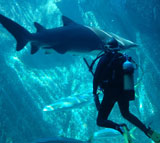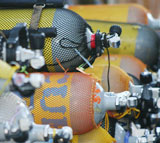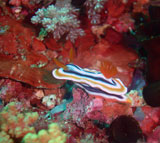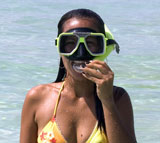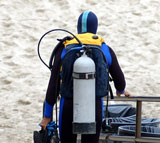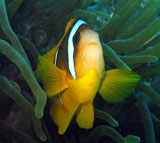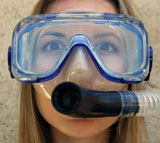Diving Physiology
by Conrad H. Blickenstorfer
What? More complicated stuff to learn, you might say. Wasn't the "Physics" section enough? All I want to do is go diving. True, but diving means to enter into an environment that is not natural for humans, and that makes studying physiology as it relates to being underwater necessary. See, physiology is defined as "the biological study of the functions of living organisms and their parts." Before anyone goes diving, s/he needs to know how being underwater affects our body. It's a simple as that.
In the Physics section we described buoyancy, how sound and light are underwater, and, most importantly, the impact of increasing water pressure on gasses. In this section we'll explain what those physics phenomena can do to our bodies. Truth be told, a lot. You'll read some scary stuff, but then again, a lot of things we do every day are potentially dangerous or even deadly. However, if we spend the time to learn how to do them right, they are perfectly safe. An example is driving a car. Hurtling along in a 4,000 pound contraption of steel at 70 miles per hour can be deadly, but since we learn how to drive, it's usually just a routine and even enjoyable experience, one we can do almost automatically and while listening to music or even conducting a phone conversation.
So what does diving physiology entail? That would be knowledge of how water pressure impacts our bodies, what can happen, why it can happen, how to recognize symptoms, and what to do in case of an accident. But it also includes things that can happen even before you go underwater.
Sea sickness
Let's start with something that can happen above water, and it's really annoying when it happens: sea sickness. It's an awful feeling and definitely not what you need when you're about to ferry over to some really terrific diving spots. Some people are susceptible to it, others much less or not at all. For those who are there are some simple rules that may minimize the effect:
- Larger boats rock less than smaller ones
- Don't eat greasy, heavy foods before you go
- Don't drink too much alcohol
- Don't get dehydrated
- Don't party all night
There are several over-the-counter seasickness prevention drugs that work quite well (Dramamine, Scopolamine, Bonine, etc.). Some are pills, others come as skin patches. Some divers swear that "Sea-Bands" work. The British Navy developed those wrist bands and they use acupressure principles. Ginger is also said to keep sea sickness away.
There is much discussion of what works best. Unfortunately, there are no definite answers. Some actually get nauseous from Dramamine, some say it works less well for women than for men, and so on. Personally, Bonine works for me, and so I am sticking with it.
The effects of pressure
Being underwater means being under pressure, and that pressure increases rapidly as you dive deeper. That means that the various gas laws come into play, and those laws can impact the "function of living organisms and their parts," i.e. YOU. So let's quickly revisit those laws: Boyle's law says that as gas pressure increases, gas volume decreases. Charles' law says that with constant pressure, gas volume increases and decreases with its temperature. Dalton adds that in a mix of gasses, the total gas pressure is equal to the sum of their individual pressures. And Henry, finally, figured that the amount of gas that will dissolve in a liquid is a function of its partial pressure and how easily the liquid absorbs gas.
The most important issue here is that, in accordance with Henry's law, the increasing pressure correlates to increased absorption of nitrogen. Once the pressure decreases as you ascend, it takes that nitrogen time to get safely released from the body. If we ascend too quickly, the nitrogen bubbles can get too large to safely be eliminated through breathing, and that can have dire consequences. We'll discuss all this in some detail.
Unfortunately, there's more. Other indirect effects of underwater pressure include shallow water blackout, oxygen toxicity, carbon monoxide toxicity, nitrogen narcosis, and full blown decompressions sickness.
Shallow Water Blackout
This is an odd but dangerous syndrome based on the little-known fact that it is not the lack of oxygen that creates in us the urge to breathe, but the build-up of carbon dioxide. Normally, as the oxygen level in the blood falls, the carbon dioxide level rises and we feel a need to breathe. When diving, things can be a different. For example, a breath-hold diver may rapidly take a number of deep breaths before diving. That hyperventilation removes carbon dioxide and thus increases the period of time before s/he'll be overcome with the urge to breathe again. Once underwater, the diver may use up oxygen without feeling a need to breathe, and eventually s/he may black out from insufficient oxygen in the blood, a state called hypoxia. A similar thing may happen when a breathe-hold diver goes deeper. Upon ascent, the oxygen pressure drops below the level to sustain consciousness. This is called deep water blackout.
Oxygen Toxicity
Oxygen toxicity means having too much oxygen in one's body. Too much? Aren't we able to breathe even 100% oxygen? Yes, but only under certain conditions. When diving, the rising water pressure increases, according to Dalton's Law, the partial pressure of oxygen. Oxygen represents about 20% of air at sea level. However, while that percentage stays the same at depth, we inhale many more oxygen molecules. At the 130 feet dive limit for recreational divers, the number of oxygen molecules we inhale would represent 100% oxygen at the surface! Under pressure, oxygen atoms don't always combine with something else, and roam as free radicals. Not good.
Symptoms of central nervous systems (CNS) oxygen toxicity, the kind most often experienced by divers and also called the "Paul Bert" effect, include tremors and seizures, ringing ears, nausea, tunnel vision and a dry cough. This can lead to drowning or decompression damage when a diver ascends too quickly in response to those symptoms. Beginning and recreational divers don't generally have to worry about CNS as it is not much of an issue unless you go below 200 feet. Another type, pulmonary, or whole-body, oxygen toxicity, also called the Lorraine Smith effect, can cause irreversible lung damage, but generally only occurs from very long exposure, much longer than what we endure during recreational dives.
Oxygen toxicity may occur at much shallower depths if a diver uses Nitrox, a breathing gas that contains a larger percentage of oxygen and a lower percentage of nitrogen than air. Nitrox is increasingly popular as it decreases the risk of nitrogen narcosis and excessive nitrogen absorption, thus reducing the risk of decompression sickness and allowing a diver to stay down longer. Proponents of Nitrox report less fatigue after diving and a greater degree of "clearheadeness" while diving with Nitrox in addition to its other benefits. Nitrox is available with various levels of oxygen, and Nitrox air tanks usually have a bright green and yellow band. Nitrox 1 consists of 32% oxygen, Nitrox 2 36% oxygen, and some advanced divers go as high as 40%. Hey, the motto of our very own Carol Cotton Walker is, "Air sucks, Nitrox rocks!"
Carbon Monoxide Toxicity
Carbon monoxide is an odorless, tasteless gas coming from the combustion of organic matter. It combines with blood, hemoglobin really, much more easily than oxygen, some 200 times more readily in fact. It also won't easily let go of the hemoglobin and that means the blood can carry less oxygen. Carbon monoxide poisoning can happen if a faulty or poorly maintained air compressor adds carbon monoxide into the tank or if it sucks in already contaminated air.
At depth, while the partial pressure of carbon monoxide remains the same, the diver inhales many more carbon monoxide molecules, enough for poisoning symptons such as headaches, confusion, tunnel vision and worse. Divers may pass out because there is no longer enough oxygen. Signs of carbon monoxide poisoning are flushed lips and cheeks. First aid treatment is pure oxygen and fresh air. In serious cases recompression in a chamber with 100% oxygen may bee necessary to reduce, or eliminate, longterm damage.
Smokers already inhale carbon monoxide and are therefore at greater risk for hypoxicity (being low on oxygen).
Nitrogen Narcosis
Our old friend nitrogen again! As if the dissolution of nitrogen into a diver's blood -- and the problem of subsequent removal from it on ascent -- weren't bad enough, nitrogen also becomes an anaesthetic under pressure. That's most likely because it interferes with the proper electrical traffic between nerve cells. So most divers experience what has been called "Rapture of the Deep" at around 100 feet or so. Signs of nitrogen narcosis are euphoric feelings, fixations, lapses in concentration, a loss of good judgement -- all a bit similar to the effects of alcohol. The onset of nitrogen narcosis varies from person to person, and some drugs can make it worse. Unlike the effects of alcohol, though, nitrogen narcosis goes away instantly as the diver ascends.
What do you do when nitrogen narcosis strikes? Simply enjoying it is a very bad idea as it will cloud judgement and good sense. So don't descend deeper than where you feel the onset of nitrogen narcosis. Keep an eye on your buddy and make sure s/he is okay. If it strikes, ascend until the feeling subsides.
Decompression Sickness (DCS)
And nitrogen again! It is vitally important to understand Decompression Sickness and what causes it. We again have Henry's and Dalton's laws at work: More gas will dissolve in body tissues under pressure (Henry), and there will be more of each gas under pressure, though the percentages stay the same (Dalton). So as we descend, nitrogen gets absorbed into our body tissues. Those tissues high in fat absorb a lot, other tissues less. And tissues that have a large blood flow will absorb and release gas more quickly than tissues with less blood flow, such as tendons, cartilage, or fat.
So what happens is that we absorb a bunch of nitrogen that will then have to be released again as we come back up. If the pressure is released slowly, the nitrogen "out-gasses" slowly and will safely travel to the lungs where we breathe it out. However, if the pressure drops
too quickly, nitrogen bubbles form in the blood and that can be very bad. While tiny little bubbles, generated by slow, controlled acent, are harmless, large bubbles
can get stuck and create blockages. They may block circulation, and compress nerves because those are surrounded by fatty
tissue that absorbs a lot of nitrogen, or create dangerous chemical reactions.
You will hear divers talk about the "bends" or having been "bent." That's because nitrogen bubbles blocking circulation in the small veins of joints (elbows, knees, shoulders) cause pain that a diver may seek to relieve by bending those joints. Even very experienced divers can get bent, so do take this very, very seriously.
There is Type I DCS and Type II DCS. Type I - the non-neuralgic type - is less severe and may manifest itself as rashes on the skin or joint pain, plus sometimes fatigue and vertigo. The more serious Type II neuralgic DCS, caused by larger bubbles that block blood flow can result in weakness, paralysis, nausea, vomiting, tingling sensations, personality change and worse. First aid in mild cases is 100% oxygen, drinking lots of fluid, aspirin as a blood thinner, and plenty of rest. Type II DCS requires recompression in a hyperbaric chamber, and the faster the better. That way, the bubbles dissolve again and are properly and slowly eliminated through slow recompression.
Can DCS be avoided?
Yes, in most cases, by following safe, proper diving procedures. While it is very difficult to exactly predict how much nitrogen is absorbed by the wide range of human bodies, there are models and algorithms that give fairly accurate approximations. Dive tables let divers determine how much nitrogen is absorbed, how long they can safely remain at a certain depth, and how quickly they may dive again. Dive computers do the same thing, only more quickly and more accurately. There are also some other rules:
- Ascend slowly to allow plenty of time for the nitrogen to out-gas
- Make a one minute stop at half your maximum dive depth
- Make a 3-5 minute safety stop at 15 feet
- Always do the deepest dive first
- Never dive dehydrated
- Allow extra surface interval time between dives
- Allow 12 to 24 hours before you fly in an airplane after diving
In addition, do take your own personal conditions into consideration. Body size and shape, physical condition, medications, diving frequency, hormonal impact, injuries, smoking, etc., will all influence your susceptibility to decompression illness.
|

